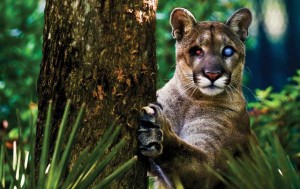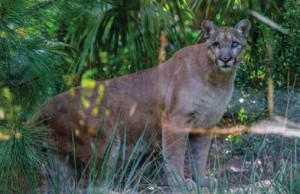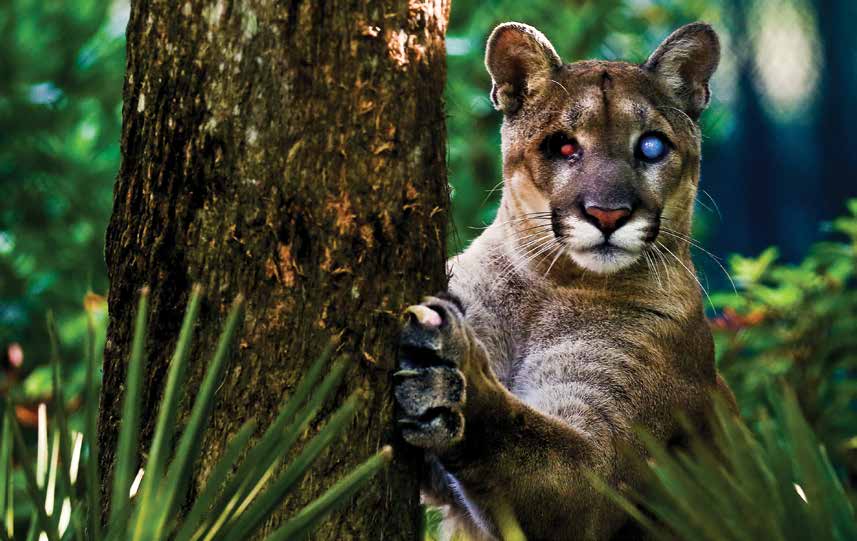SURVIVING A SHOTGUN – One Panther’s Story
by Tim L. Tetzlaff
Naples Zoo Director of Conservation
 Walking through the woods one spring day, a Florida panther looked for a palmetto thicket where she would give birth. Deer fawns were also being born in the southwest Florida wilderness while the panther delivered her kittens. It was no coincidence. A mother needs abundant prey so she can stay close to her den to protect and nurse her kittens. Over the next 18 to 24 months, the blue eyes and spotted coats of the newborn kittens changed to the yellow eyes and tawny coat of their mother and they struck out on their own. Like other panthers, they faced
Walking through the woods one spring day, a Florida panther looked for a palmetto thicket where she would give birth. Deer fawns were also being born in the southwest Florida wilderness while the panther delivered her kittens. It was no coincidence. A mother needs abundant prey so she can stay close to her den to protect and nurse her kittens. Over the next 18 to 24 months, the blue eyes and spotted coats of the newborn kittens changed to the yellow eyes and tawny coat of their mother and they struck out on their own. Like other panthers, they faced
the threats of disease, attacks from other panthers, and the dangers of crossing our roads. But one of these cats met a different challenge. This panther looked up at the barrels of a shotgun – the last thing he would ever see.
Young panthers, especially males, wander far looking for a new home and can find themselves close to people. Sometime after leaving his mother’s protection, this two-year old cat encountered one of us. When panthers and people meet, it’s typically a fleeting encounter. On rare occasions, however, it can be bad for either side – whether it’s us hitting them with a car or them eating one of our dogs, goats, or calves. But where this cat was and what prompted someone to act remains a mystery.
What’s clear is that one of our kind took aim and pulled the trigger – twice. One barrel tore into his hindquarters and the other impacted directly into his face. The flying pellets irrevocably shattered the lens of one eye and entirely collapsed the other.
 But he was left with his life, just not the one most panthers expect. Now blinded, bleeding, and carrying shot in his face and right leg, he began a six-week trial to find food, fight infection, stay clear of fellow panthers, and avoid cars. The latter was no easy feat as biologists theorize he was surviving on road kill. And that might have been his end had it not been for an alert driver who slammed on the brakes after seeing this cat walking in the road.
But he was left with his life, just not the one most panthers expect. Now blinded, bleeding, and carrying shot in his face and right leg, he began a six-week trial to find food, fight infection, stay clear of fellow panthers, and avoid cars. The latter was no easy feat as biologists theorize he was surviving on road kill. And that might have been his end had it not been for an alert driver who slammed on the brakes after seeing this cat walking in the road.
When Florida Fish and Wildlife Commission biologists arrived, the panther was still in the area and visible – odd behavior for these cats. The logical assumption was made that it may have been hit in a prior incident. After anesthetizing him, they took him for urgent care at the Animal Specialty Hospital of Florida where the truth of his condition was revealed. Immediately after, he received critical care at Tampa’s Lowry Park Zoo where he was christened Uno as he was the first animal treated in their new veterinary hospital. Clinically blind, he may only
have some sense of light and shadow at best.
After his initial rehab, we welcomed him here at Naples Zoo in December. Uno has been cared for by the Zoo’s carnivore team in a behind-the-scenes area where he has free choice of inside and outside spaces. “Along with direct observation, we use remote cameras to monitor Uno’s activities during the day and night,” explained Naples Zoo’s Director of Animal Programs Liz Harmon.
“Given the trauma he experienced, he’s adapting quickly and moving around very well and even playing with the various behavioral enrichments.” The Zoo’s carnivore keepers are also training Uno to sound cues and offer gentle, reassuring tones as they help transition him to a life without sight.
Naples Zoo has created a permanent home for Uno that opened July 2015. The focus of the new exhibit is to expand public awareness of the issues surrounding the growing number of cats in the area.
“And to meet the increased need to care for injured or orphaned panthers,” explains Naples Zoo President and CEO Jack Mulvena, “we’re also creating habitat space to provide temporary care along with fundraising for an all-new large animal veterinary clinic.” This new facility will provide officials with a local facility to act even quicker by providing an alternative to moving cats several hours away in the state – an especially useful option for a cat that only needs short-term observation for a few hours or few weeks.
This is part of a cooperative effort with the USFWS and FWC to meet their needs in recovering the state’s panthers. With as few as 20 to 30 cats surviving in the 1970s, Florida panthers once teetered on the very edge of extinction. Several decades of conservation efforts for this federally listed endangered species have resulted in a population estimated between 100 and 180 cats. While still a critically low number for recovery, that growing number does increase the chance for interactions between cats and humans. Educational components of the new exhibit will engage guests in the balanced discussion of saving endangered species and living with large predators.
Far from the simple menageries of past, today’s nationally accredited zoos are centers of learning and natural crossroads for biologists, educators, environmental scientists, and researchers – as well as for students, conservationists, and all animal lovers. Naples Zoo at Caribbean Gardens is a trusted, private 501(c)(3) nonprofit serving wildlife and families here and around the world. More information at www.napleszoo.org.


Leave a Reply
Want to join the discussion?Feel free to contribute!